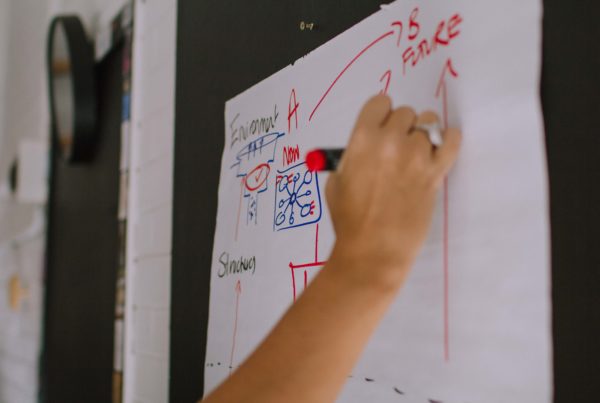This article aims to accelerate the impact of sustainability change leaders by shedding light on the innermost thoughts and fears holding these inspired leaders back from creating the positive changes they are capable of and offers some practical, simple, reflective actions to help overcome them.
Since the majority of my clients leading sustainability change have a typical ‘technical expert’ behavioural profile (highly qualified, industry-experienced, deep disciplinary expertise, published and sometimes awarded), they share common but often unspoken challenges.
These challenges, alongside my suggestions for powerful remedies, are:
- OVERWHELM CAUSING A LACK OF STRATEGIC CLARITY
The smartest people in the room – and indeed, the country – who are charged with leading change and creating positive sustainability impact can feel overwhelmed with the weight and urgency of sustainability challenges.
Knowing we have the capability to affect change is offset by the magnitude and urgency of the challenges, which creates an exhausting internal tension in the hearts and minds of sustainability leaders.
It’s the sense that there’s so much we can do, but our progress and impact are never big or fast enough. In the words of one of my senior sustainability change leader clients, we’re scared we’ll always be ‘p*ssing into the wind’.
The experience of overwhelm can lead to scattered approaches and a lack of strategic clarity and focus (we’re left wondering: ‘what are we really doing here?’).
Soon enough, we’re lost and spinning our wheels in low-quality problems that reside well beneath the limits of our intellectual and practical capacity to effect change.
The corollary of the lack of strategic clarity and overwhelm is the tendency for leaders to dive inwards into their organisational environments and tinker with the minutiae of low-level operational planning, restructuring staff deployment, financial controls and other ‘solvable’ but low-quality internal quandaries which feel administratively productive in the short term – but of course, prevent us from accelerating our outward impact.
We become busy instead of focused. Urgent instead of clear thinking. Excitable instead of evaluative. Lost instead of leading. Critical instead of visionary. Conservative instead of bold. Administrative instead of impactful.
Remedy: In these moments, we must create some distance from the overwhelm to evaluate our direction, hone our focus, and engage our stakeholders in a strategy and planning reset to create alignment.
Such a ‘strategy reset’ benefits from external facilitation, so the change leader can be a participant in the review (rather than straddling the roles of facilitator and participant, which can railroad and compromise even the most well-intentioned process).
Need facilitation help for sustainability change and strategy conversations? Get in Touch
- NETWORKING EXHAUSTION
For introverted technical experts leading sustainability change while enjoying broad, collegiate and functional professional collaborations, the idea of ‘networking’ is right up there with poking oneself in the eye with a fork.
As it happens, the technical expert behavioural profile is also most comfortable where a long-term, mutually respectful and deep partnership can be maintained and leveraged in preference to entertaining the perspectives and potential of newer, less familiar players.
Unsupported by targeted connectivity strategies, they can tend to find the ‘work’ of growing professional networks quite like digging for precious metal without a metal detector – unpredictable and infrequent benefits, exhausting, messy and undignified in its commerciality.
Without a strategic and healthy approach to building and maintaining professional networks, critical relationships can weaken and dissolve over time, or worse, we exhaust ourselves maintaining connections that deliver few practical benefits – leaving leaders exposed to a lack of deep, cross-boundary, intra-disciplinary relationships to collaboratively enact systemic change.
Remedy: The first step is to strategically map key stakeholders and make a plan to target the development of only the most powerful, leveraged relationships where we seek to uncover mutual interests, collaborative benefits and convert aligned approaches into action.
This takes time and considered planning, and may even begin with the admission that we don’t know where to start with identifying high-value stakeholders and collaborators.
* NB: This doesn’t mean only connecting only with senior players. It means connecting with the stakeholders with the most capacity to influence, lead transformative action and leverage collaborations for broader benefit. Often, these can be the people ‘on the ground’.
A stakeholder map can be as simple as a mindmap/spider diagram that identifies the key players and their interests, so that relationship development can be prioritised strategically.
This is also a great activity to do with your team. If you need help with this, just say the word – Contact Me Here.
- POLITICAL ASTUTENESS & SELF REGULATION
It follows that where our professional networks aren’t strategically developed and matured over time, we’ll also have limited ability to identify and incorporate the needs and perspectives of diverse stakeholders across government, industry/business, financial markets, educators and communities.
This leaves sustainability change leaders tripping over competing agendas, communicating the wrong thing to the wrong person at the wrong time, and experiencing disheartening setbacks or a lack of support in important projects due to deficits of common language, cross-boundary collaboration and aligned action.
We feel buffeted by the crosswinds of competing and misaligned interests, which can be an exhausting and disheartening experience.
It can also manifest in a preference for engaging with ‘friendly’ players in preference to those who can effect the most significant positive change – but whose interests and needs are harder to discover and accommodate.
Remedy: Self-regulation and political maturity are required to ‘play the long game’ and make measured, strategic contributions to advancing sustainability conversations.
Where stakeholders are seeking certainty about the future costs and benefits of sustainability approaches, the ability of leaders to create and facilitate forums with the right people for powerful conversations, and to hold a position of authority with calm steadiness in messaging, is key to becoming increasingly influential.
- NAVIGATING WICKED PROBLEM COMPLEXITY AND SCALE
Sustainability problems are systemic and wicked. They exist at the global, national, regional, industry, enterprise, community and individual scale, and everywhere in between – all at once.
The ability for leaders to cognitively ‘scale down’ in deductive reasoning and problem solving to embrace and incorporate complexity, then turn on a dime to crystallise and inductively ‘scale up’ to tangible, summarised concepts and practical decisions / actions, is critical to navigating complex discussions and cutting direct pathways to impact.
The key risk for the technical expert, as a sustainability change leader, is usually not in ‘scaling down’ into detail and complexity but in ‘scaling up’ into broader concepts that make aligned understanding and decision-making across diverse stakeholders possible.
Without the ability to scale up and down effectively in conversation, the change leader will be unable to keep pace with important conversations, will be contributing only within a partial, narrow range of the problem space, and as a result, might lose the engagement of critical stakeholders operating at different scales.
Furthermore, it’s simply not the typical behavioural preference of technical experts to think in the grey’ big picture’ and ‘futuristic’ spaces, preferring instead to gravitate toward black-and-white data, fact and documented proof.
This default behaviour can lead the sustainability leader down the ‘technical expert’ rabbit hole, where we can get stuck in the narrowness of intricately technical problems rather than influencing broader systemic change, especially if we’re not supported to grow our ability leadership at scale.
Remedy: Scaling up and down in complexity is a skill set that change leaders can develop through leadership coaching, development and applied practice.
This means we will be able to map stakeholders, identify interests, connect concepts, create and lead conversational forums, facilitate strategic thinking alongside practical problem solving, and align diverse stakeholders across various community, business, industry, regional, state, national and global scales.
A powerful activity to get started with scaling is to:
- Identify the relevant scales at which your sustainability challenge presents – individual, community, enterprise, industry, regional, national, global (hint, every wicked problem is a symptom of a higher level problem);
- Map the critical concepts, challenges and possible solutions evident at each level;
- Identify key stakeholders and their mutual and competing interests;
- Make a plan for how to link concepts around mutual interests to engage more robustly with stakeholders.
Again, this activity benefits from facilitation so that sustainability change leaders can be powerful players in the substantive discussion rather than ‘referees’ of the process and its contributors. Get in touch if I can help you with this conversation.
- LOSING SIGHT OF OUR IMPACT & WAVERING CONFIDENCE
Another characteristic of wicked problems such as sustainability change is that the ‘problem’ is never fully solved. Rather it continues to evolve organically to new dimensions over time.
In this context, sustainability change leaders can easily lose sight of the value of small wins and forget to reflect upon what we’ve contributed to both on-the-ground solutions and the broader agenda.
We might even forget what it’s like to succeed at all – and worse, perhaps start to believe the cause itself is pointless and, therefore, not worth influencing.
At this moment, we consider our career options, bookmark a ‘Seek’ job search, fantasise about going it alone in consulting or in a business that requires less of our mental and emotional capacity or even consider early retirement.
A loss of faith in our ability to create a positive impact can lead to a dissolution of confidence in the longer term, reducing our certainty about the overall relevance of our work and, worse, a loss of faith in our own capabilities and value.
Remedy: I recently advised a client on a steep development trajectory to actively reflect upon the long list of successes she’s created with her team over the past 12-18 months and to commit this list to paper.
Her results and refreshed perspective were both remarkable and inspiring. She moved from feeling overwhelmed, exhausted and stuck to energised, meaningfully contributing and actively leading and growing.
Better still, conducting a success stocktake with our teams and collaborators will allow us all to experience the refreshing sensation of success that can sustain us during setbacks, shows us the formula for what works, and help us remember and appreciate the cumulative effect of our contributions.
- PERSONAL SUSTAINABILITY
As you will have gleaned, the work of sustainability change leadership is long-term, complex and can be personally taxing.
Many sustainability change leaders will experience exhaustion, burnout, health crashes and deterioration, may develop addictions or unresourceful coping strategies, suffer disillusionment, crises of confidence and even disengagement from their mission.
This doesn’t just affect the sustainability change leader but their teams as well.
Our people respond to the clarity of our strategic intent, energy, results, and the power of being part of something special – and where we can’t create and communicate those things effectively, engagement and morale suffers.
Leading ourselves well is critical to being able to physically, mentally and emotionally sustain the long-term effort required for impactful sustainability change leadership.
Remedy: This looks like self-propelled leadership and personal development, self-reflection and openness to feedback, emotional regulation (as much to manage excitement as disappointment and setbacks), and learning the skillsets of influencing, executive presence, strategic networking and facilitation.
In summary, six common but undiscussed challenges of sustainability leaders include overwhelm leading to a lack of strategic clarity, the challenge of strategically building and maintaining networks, political astuteness and the self-regulation required to play the long game, navigating the scale and complexity of wicked problems, wavering confidence and losing sight of impact, and personal sustainability and resilience.
These are worthy of our consideration in sustainability program and project development, leadership coaching practice, leadership development programs and the facilitation of strategy, planning and problem-solving / co-creation forums and workshops.
As a leadership coach and facilitator, I help navigate these challenges on a daily basis and intimately understand and leverage the nexus of leadership and personal development.
For now, my encouragement is to reflect upon this article and ask yourself: “What is the one most important action I can take to more powerfully lead sustainability change today?”
If these common fears and challenges of sustainability change leaders resonate with you too, and you’d like to talk more about what successful net zero / sustainability change leadership requires in terms of leadership coaching, leadership development, strategy and planning facilitation, please reach out for a conversation.




